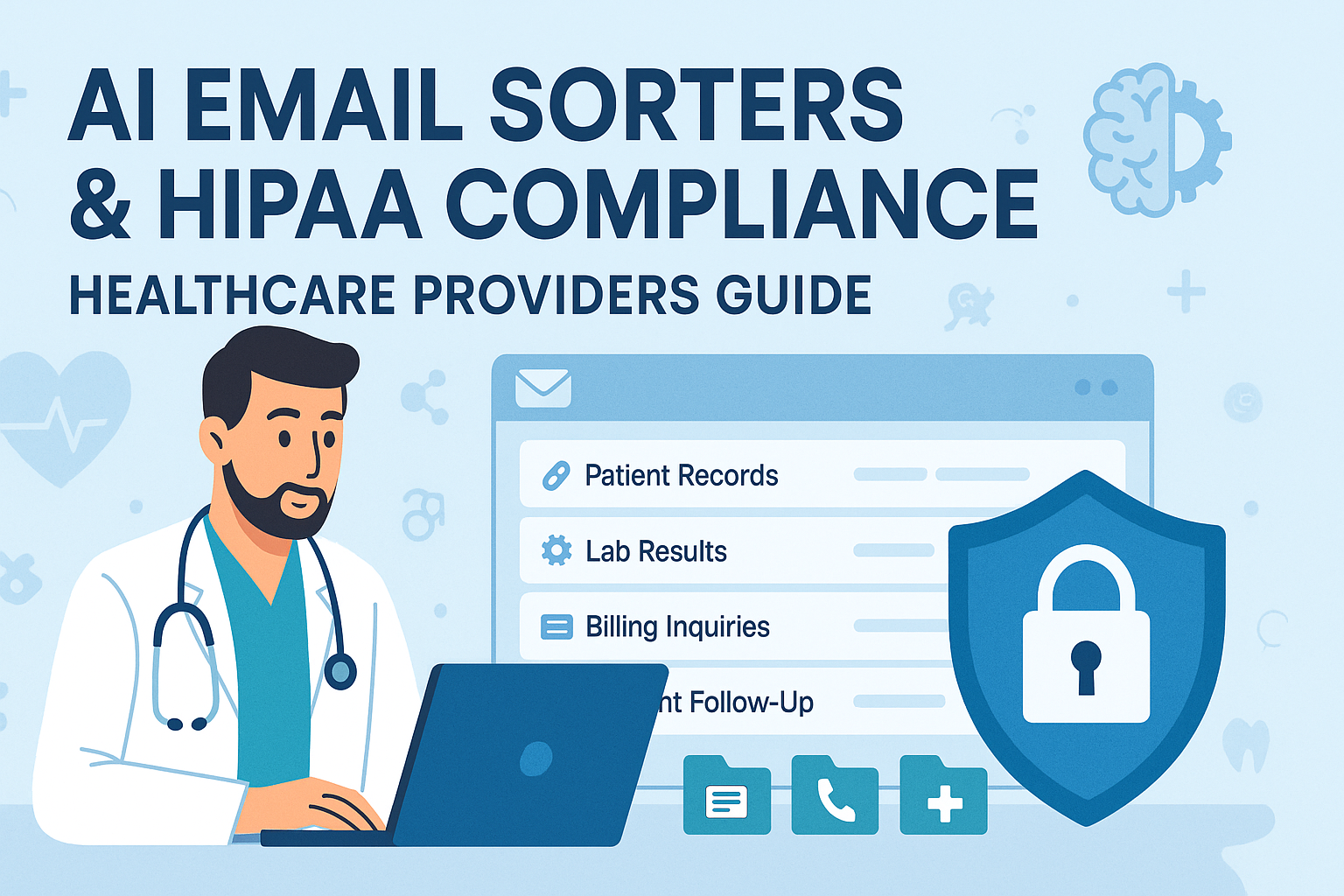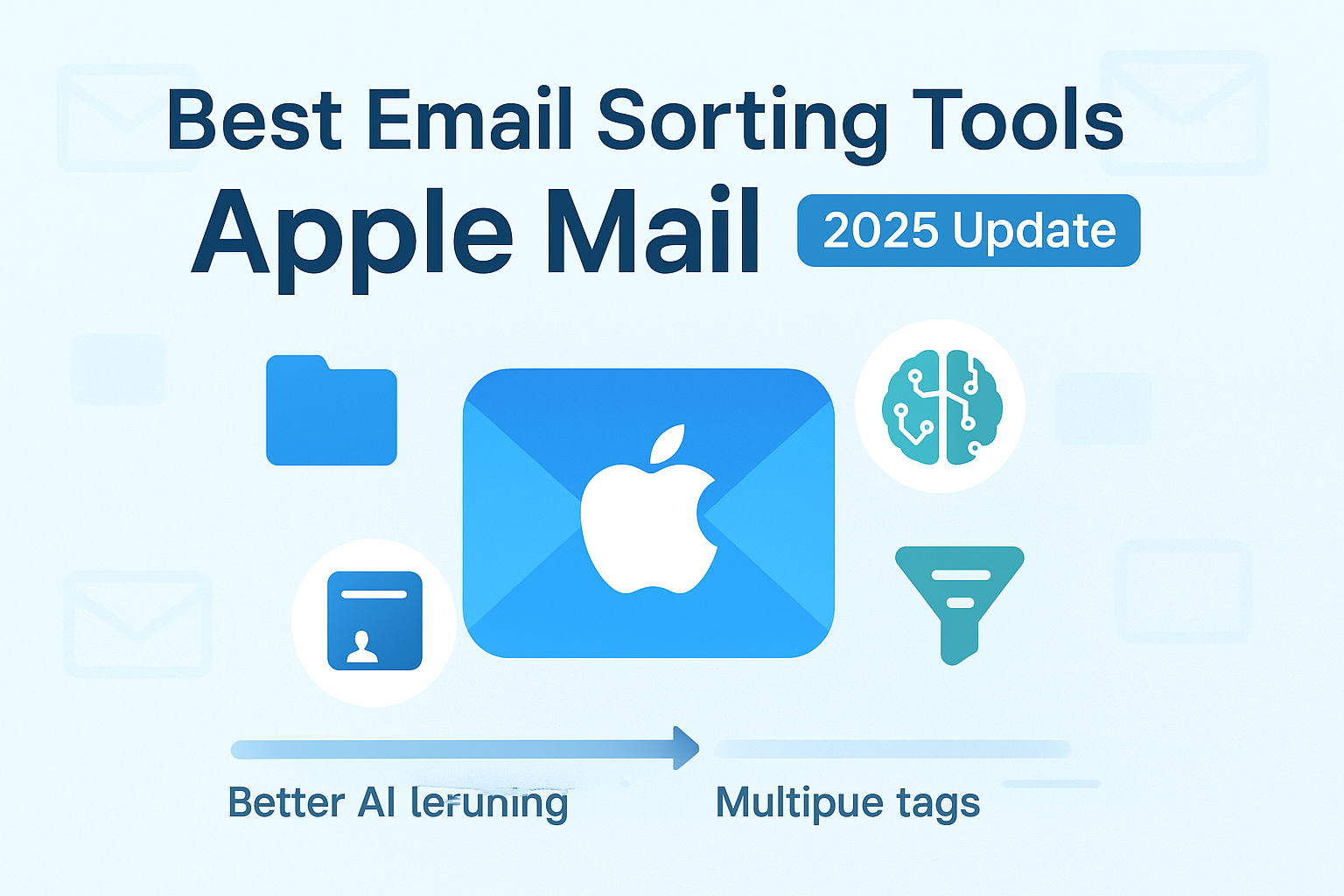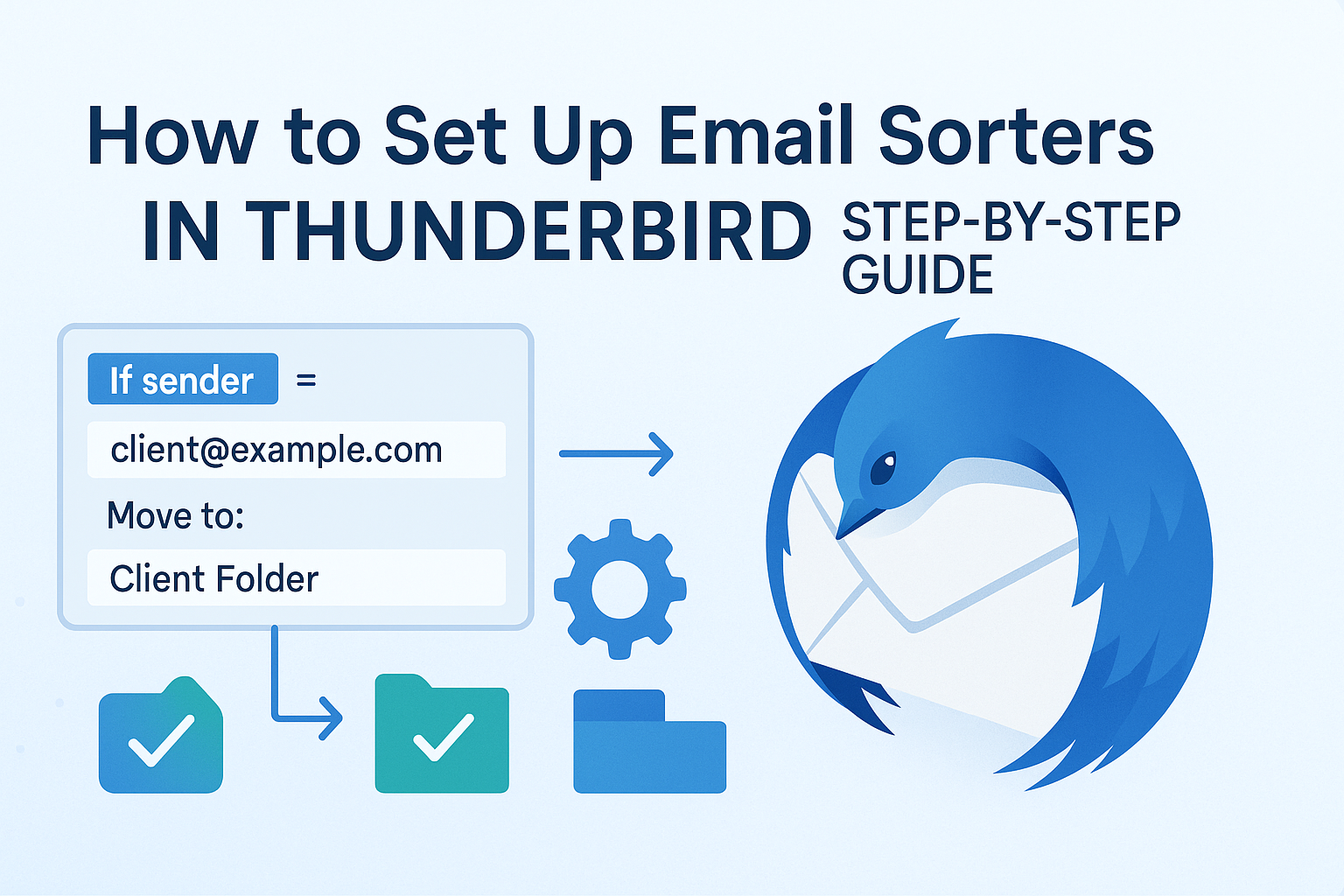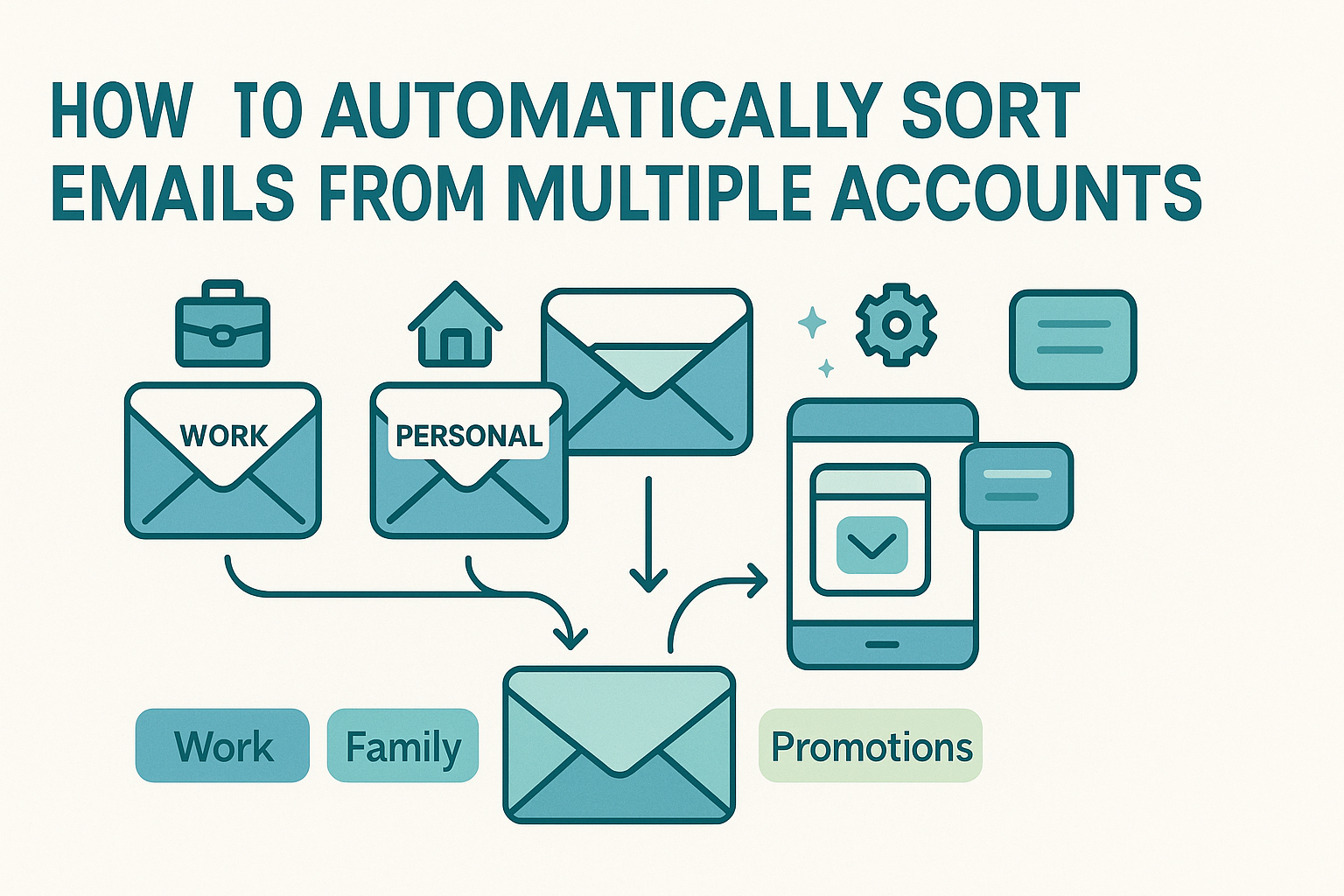Are AI email sorters HIPAA-compliant? It’s a key question for healthcare providers using AI to manage inboxes and sort attachments. These tools offer speed, automation, and less manual work, but in healthcare, compliance with HIPAA matters more than convenience.
If your emails involve protected health information (PHI), you need to know how AI tools handle privacy, security, and data access. This guide breaks down what HIPAA requires, how AI email automation fits into those rules, and what safeguards your organization must have in place.
Whether you’re a clinic manager, IT lead, or healthcare administrator, you’ll learn how to use AI in healthcare email tools, without risking a violation.
What Are HIPAA Requirements for Email Communication
To understand how AI email sorters fit into a HIPAA-compliant workflow, we must first revisit the law’s expectations regarding email.
HIPAA consists of several rules, but two are most relevant here: the Privacy Rule and the Security Rule. Together, they require covered entities, such as hospitals, clinics, insurers, and associated vendors, to protect PHI during storage, transmission, and handling. When email is involved, that means encryption, controlled access, audit trails, and clear documentation of risks and safeguards.
Email communications in healthcare often contain PHI, whether it’s appointment confirmations, referrals, scanned lab results, or billing information. The moment a sorting tool accesses or processes these emails, even just to apply labels or organize folders, it is interacting with PHI. That makes the tool subject to HIPAA requirements.
This includes the need for a risk analysis, which must document the types of data being handled, the threats posed to it, and the measures in place to mitigate those threats. Failing to conduct a risk analysis, especially when introducing AI or cloud tools, is one of the most common ways organizations fall short of HIPAA standards.
The Rise of AI Email Sorting Tools in Healthcare Settings
Email sorting tools have evolved dramatically over the past decade. What began as rule-based filters—if sender is X, move to folder Y—has now become a landscape dominated by machine learning. These systems analyze language patterns, attachment types, and behavioral cues to predict how messages should be sorted.
In healthcare, AI-powered sorters can be used to separate patient inquiries from internal communications, identify appointment confirmations, or route lab results to specific teams. They reduce time spent manually filtering emails, increase speed of response, and help staff focus on care delivery rather than inbox management.
But the capabilities of AI email sorting technology also raise new concerns. These systems may “learn” from the content they process—potentially absorbing patterns from PHI or training their models using live email content. If the AI is hosted in the cloud or if training data is stored outside a controlled environment, HIPAA risks can multiply.
It’s also worth noting that not all claims about AI are accurate. Some tools marketed as “intelligent” are still based on deterministic logic, while others use more advanced machine learning algorithms. Understanding what the AI is doing under the hood is essential when evaluating risk.
Technical Safeguards for HIPAA-Compliant AI Sorters
HIPAA doesn’t ban AI, or even cloud tools. What it mandates is adequate protection of health information. That means any AI email sorter used in a healthcare setting must include specific technical safeguards.
First, encryption is mandatory. Data must be encrypted both at rest and in transit. This protects emails and attachments from interception during transmission or exposure through a breached server. Tools that use TLS (Transport Layer Security) for email delivery and AES (Advanced Encryption Standard) for stored data meet this requirement.
Second, authentication and access control must be in place. Every user should have a unique login, and access to sorting logs or filtered messages must be limited by role. Additionally, the system should maintain audit logs, documenting who accessed what and when—a key part of HIPAA’s traceability requirements.
Third, you must consider where the data is hosted. If the AI tool stores email content or logs in a data center outside the United States—or in a non-compliant region—this could be a red flag. HIPAA requires that PHI not only be protected, but that its storage and handling align with U.S. privacy standards. That makes data residency a serious factor when choosing a platform.
Finally, and critically, the vendor of your AI email sorter must be willing to sign a Business Associate Agreement (BAA). This legally binds them to HIPAA compliance and affirms that they understand their role in safeguarding PHI. Without a BAA, even a well-secured tool would be considered non-compliant if it handles patient data.
For guidance on what cloud-based email sorting tools must include to meet HIPAA encryption and storage standards, refer to our post on secure cloud email sorting.
Legal Considerations for AI-Powered Email Sorting
From a legal perspective, HIPAA compliance hinges on responsibilities, not technologies. When an email sorting tool handles PHI, the company providing it is considered a Business Associate under the law. That triggers a host of legal obligations.
One of the first steps healthcare providers must take is to determine whether their vendor is indeed a Business Associate. If the tool stores, accesses, or analyzes emails on behalf of the covered entity, even passively, it likely qualifies. The only exceptions are tools that operate entirely on the client side with no cloud connectivity.
Once that’s established, a Business Associate Agreement must be signed. This contract sets forth how the vendor will protect PHI, what safeguards they use, how they report breaches, and what happens if compliance fails. Without this BAA, both the provider and the vendor could face HIPAA penalties in the event of a breach.
Risk analysis must also be conducted before implementation. HIPAA mandates that covered entities assess the security risks introduced by any new technology, especially AI. That means documenting what kind of data the sorter will access, where it’s stored, who can access it, and how it’s protected. This isn’t just best practice, it’s a compliance requirement.
Lastly, any agreement with an AI sorting vendor should include clear liability clauses. If the sorter misrouted an email containing PHI or fails to detect a breach, who’s responsible? What if the AI model inadvertently stores sensitive information during training? These scenarios must be covered in writing to protect both parties.
Practical Workflow Considerations for Healthcare Providers
Legal documents and encryption protocols are vital, but so is how AI email sorters function day-to-day in real healthcare environments. HIPAA compliance depends just as much on how tools are used as on whether they’re technically capable.
AI email sorters must be implemented as part of a broader workflow, not a standalone black box. That means including manual review points when appropriate, especially for messages that don’t fit into a predefined category. Over-relying on automation without oversight can lead to misfiled PHI, delayed responses, or patient complaints.
Staff training is essential. Everyone interacting with the system, nurses, front desk staff, IT admins, should understand what the sorter does, what its limitations are, and what to do if it fails. Policies should also be updated to include how email sorting is audited, when it can be overridden, and who’s responsible for monitoring accuracy.
Errors and exceptions must be part of the process. If the AI misclassifies a message or fails to detect a PHI-containing file, there needs to be a clear escalation protocol. This includes notifying IT, correcting the rule set, and logging the incident for future audits.
Sorting accuracy should be tracked over time. Many providers run validation tests—comparing AI decisions to human review—to maintain quality control. This can also be documented as part of your risk management strategy, showing regulators that you’re not only using the tool, but actively monitoring it.
Risk Management: Common Concerns and Mitigation Strategies
While AI email sorters offer many advantages in a healthcare context, they also introduce new risks that providers must be prepared to address. At the heart of HIPAA is the principle of risk mitigation—meaning potential threats must not only be identified but actively reduced through technical, administrative, or procedural means.
One of the most prominent concerns is the risk of data breaches. If an AI tool mistakenly routes a message with PHI to the wrong recipient or exposes sensitive data due to a misconfiguration, the breach must be reported under HIPAA’s breach notification rule. That could trigger not only reputational damage but also financial penalties.
Many providers ask whether AI systems, particularly those that use cloud-based infrastructure, are more vulnerable to cyberattacks. The answer depends on how the tool is built. Systems using proper encryption, strong authentication, and restricted access controls are generally safe—but lapses in configuration, monitoring, or vendor compliance can still lead to exposure.
To explore these scenarios and how to reduce such risks, read more about email sorting safety concerns. This guide outlines common vulnerabilities and best practices for securing AI-driven workflows.
Another challenge is the accuracy of sorting itself. AI tools that over-filter or under-identify relevant messages may misclassify critical communications. For example, a follow-up care request might be misrouted, delaying patient service. This is why tools should always allow overrides and offer logs showing how and why decisions were made.
Lastly, human error is always a factor. A staff member might wrongly adjust a rule, expose logs to unauthorized users, or fail to report a sorting anomaly. For this reason, continuous training and access control reviews are essential parts of an AI tool’s governance structure.
Comparing HIPAA with Other Privacy Standards
While HIPAA governs U.S. healthcare, many organizations must navigate overlapping frameworks—especially those with operations or partnerships abroad. A common comparison is between HIPAA and the General Data Protection Regulation (GDPR), which applies across the European Union.
HIPAA focuses on protecting health data specifically, while GDPR covers a broader range of personal data. That said, both regulations emphasize data minimization, auditability, and breach response. The main difference lies in data subject rights: under GDPR, individuals can demand access to logs that show how their data was processed.
If your organization uses AI email sorting tools across jurisdictions, it’s vital to ensure they meet both sets of expectations. For example, logs generated by AI sorters may need to be filtered or anonymized before sharing with patients or regulators in the EU.
For an in-depth look at the intersection of these two frameworks, see our detailed comparison in GDPR-compliant email sorting. It explains how to align HIPAA workflows with EU privacy principles.
Additionally, cross-border data transfers introduce new compliance questions. If your AI email sorting tool stores data in Europe or Asia, ensure that the transfer complies with U.S. and international data laws. Using standard contractual clauses or data localization features can help bridge regulatory gaps.
Multinational providers or telehealth firms serving global patients should also consider regional opt-outs and consent models when using AI to process communications. Transparency about what the tool does—and where the data goes—can protect both your brand and your patients’ trust.
Choosing the Right AI Email Sorters for Healthcare
Selecting the right email sorting tool starts with assessing its compliance readiness. Many vendors claim to support healthcare, but only a subset truly meets HIPAA requirements—particularly when it comes to handling AI-driven automation.
First, look for platforms that explicitly offer HIPAA support and are willing to sign a Business Associate Agreement. This is the legal backbone of your relationship and a non-negotiable requirement if the tool will handle PHI in any form.
Second, evaluate the tool’s security architecture. A strong solution will support both in-transit and at-rest encryption, robust access controls, and detailed audit logs. These technical layers form the foundation of HIPAA’s Security Rule. If the tool operates in the cloud, review its hosting locations, redundancy features, and breach notification protocols.
Our resource on secure cloud email sorting provides a breakdown of how to vet these technologies against regulatory benchmarks. It also explains how to configure cloud sorters for compliance using least-privilege access models and secure API integrations.
Third, review how the tool supports real-world healthcare scenarios. Does it allow custom sorting rules? Can it integrate with your EHR or CRM? Does it generate exportable logs that compliance officers can review during an audit? The more aligned the tool is with your day-to-day operations, the better its long-term value.
We’ve compiled a comprehensive list of compliant, high-performing platforms in our top email sorting software guide. These options include tools built specifically for privacy-conscious industries like healthcare, with advanced filtering, role-based access, and BAA availability.
Integration with Broader Compliance Ecosystems
Email sorting is only one piece of your healthcare communication workflow. It needs to integrate with the broader systems you rely on—electronic health records (EHRs), patient portals, ticketing tools, and compliance dashboards.
AI sorters can enhance these systems by ensuring that incoming files, referrals, or appointment requests reach the correct departments promptly. For example, a correctly sorted intake form can be routed to a triage nurse, uploaded to the patient’s chart, and tracked in the provider’s task manager—all without manual handling.
This also means that sorters must interoperate with other regulated industry systems. If you’re managing a complex environment with telehealth apps, billing systems, and internal compliance tools, see our article on email sorting for regulated industries. It shows how to unify these layers while maintaining auditability and HIPAA alignment.
For practical guidance on this process, explore secure lead routing. It walks through how to ensure that early-stage communications are compliant from the moment they hit your inbox.
Case Studies and Real-World Examples
Many healthcare organizations have successfully adopted AI email sorters—showing that HIPAA compliance and automation can indeed coexist when done carefully.
One small family clinic in Ohio implemented an AI sorter to triage patient emails by urgency. By integrating with their Office 365 system and using a HIPAA-compliant vendor, they reduced response times by 40% while maintaining audit logs for every rule applied.
A multi-state hospital system opted for a cloud-based sorter with BAA support and SSO authentication. By tagging each incoming lab result and directing it to the appropriate care team, the system ensured nothing slipped through the cracks—even during high-volume surges.
A national telehealth provider used AI to route medication refill requests, insurance verifications, and follow-up questions to the correct workflows. Each action was logged, reviewed weekly, and tied into their secure messaging dashboard—demonstrating how automation enhances care without undermining privacy.
These examples illustrate that compliance is not a barrier to innovation—it’s the framework that enables responsible digital progress.
Steps to Implement HIPAA-Compliant AI Email Sorting
Once you’ve decided to move forward with AI email sorting, the implementation process itself must follow a structured, compliance-conscious plan. This isn’t just about plugging in new software—it’s about embedding it responsibly into your workflow.
The first step is to conduct a formal risk assessment. This should document all points where PHI will be accessed, stored, or transmitted by the AI tool. It must also identify potential failure scenarios and how your organization will detect and respond to them.
Next, select a vendor that provides a signed Business Associate Agreement (BAA). This legal agreement is required under HIPAA and must clearly define the vendor’s security practices, liability in case of breach, and notification protocols.
Configure your system to apply encryption both in transit (using TLS) and at rest (using AES-256 or better). Limit access via authentication and role-based permissions, and ensure all logs generated by the sorter are time-stamped, tamper-evident, and centrally stored for auditing.
Train your users on the new system. Make sure clinical and administrative staff understand what the AI tool does, what its limits are, and when to escalate issues. This training should be refreshed periodically and documented as part of your compliance file.
Finally, establish monitoring and response procedures. Review logs weekly or monthly to confirm accuracy and detect anomalies. If an error or breach occurs, use your incident response plan to notify stakeholders, isolate the problem, and adjust your settings or rules accordingly.
Future Outlook: AI Sorting and HIPAA Compliance
The role of AI in healthcare communications is only growing. As technology becomes more sophisticated, the opportunity to automate safely within HIPAA guidelines is expanding—especially with advances in natural language processing and secure cloud architecture.
Emerging AI models are already capable of understanding context, urgency, and intent. That means future email sorters won’t just classify messages—they’ll prioritize them, identify possible risks, and even recommend next steps to staff. This has profound implications for patient engagement, care coordination, and internal communication.
Predictive safeguards are also on the horizon. These would enable AI to detect potential breaches before they happen, such as identifying when a rule might incorrectly route a message or flagging when access permissions don’t align with PHI sensitivity.
From a compliance standpoint, we’re also seeing increasing interest in AI transparency, the ability to explain exactly how an algorithm made a decision. This is crucial for defending HIPAA-related sorting practices during audits and investigations.
As federal agencies and international regulators continue to develop AI governance frameworks, healthcare providers will need to stay proactive—adopting tools that not only meet today’s compliance needs but are built to adapt to tomorrow’s legal expectations.
Conclusion
AI email sorters can be HIPAA-compliant—but only when implemented with care, clarity, and oversight. These tools offer genuine value for healthcare providers seeking to streamline communications, improve response times, and reduce administrative burden. However, the potential compliance risks require diligent planning, ongoing training, and strategic vendor partnerships.
From encryption and audit logging to access control and legal documentation, every element must align with HIPAA’s core principles of confidentiality, integrity, and availability. Tools marketed with AI capabilities should be vetted thoroughly—not only for what they promise to do, but for how they handle sensitive patient data behind the scenes.
The journey to compliance isn’t about checking a box. It’s about building a resilient, transparent system where privacy and productivity coexist. With the right frameworks, documentation, and security protocols, AI email sorters can become a trusted part of that system—helping providers stay focused on what matters most: patient care.
FAQs
Q1: Is AI email sorting allowed under HIPAA?
Yes, AI email sorters are allowed under HIPAA as long as they comply with security, privacy, and breach notification requirements. The key is ensuring PHI is protected through encryption, access controls, and proper vendor agreements.
Q2: Do I need a Business Associate Agreement for my email sorting vendor?
Absolutely. If the vendor handles or processes PHI on your behalf—even temporarily—they must sign a BAA. This is a core requirement under HIPAA.
Q3: How can I ensure audit logging is HIPAA-compliant?
Logs must include time-stamped entries, user identities, and the nature of actions taken. They must be securely stored, tamper-evident, and available for audit reviews or breach investigations.
Q4: What happens if sorting fails and PHI is misrouted?
Misrouting PHI could qualify as a breach, depending on the exposure. You must document the incident, assess risk, notify affected parties if necessary, and take corrective action—often involving rule updates or vendor reassessment.
Q5: Do AI email sorters work in hybrid cloud or on-premises environments?
Yes, many AI sorters can integrate into hybrid environments. However, configuration must be done carefully to ensure PHI does not leave secure networks or violate data residency and access requirements.




